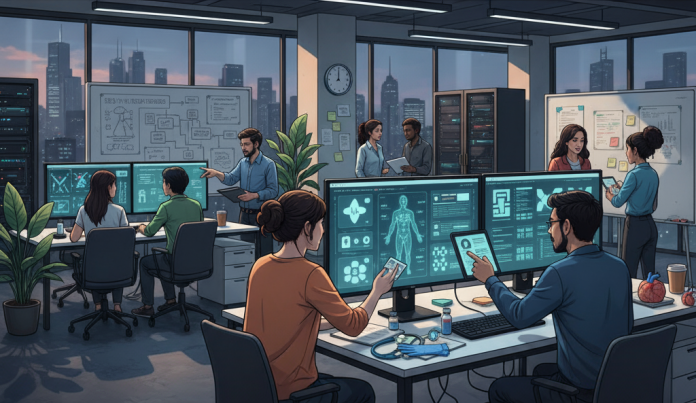The healthcare industry is experiencing a seismic, yet necessary, shift driven by digital technology. At the vanguard of this transformation lies healthcare software development, an indispensable engine for innovation that is fundamentally changing how patient care is delivered, managed, and optimized. The modern healthcare ecosystem—from large hospital networks and pharmaceutical companies to individual clinics and wearable tech startups—is increasingly reliant on sophisticated, secure, and compliant software solutions. This article delves deep into the strategic importance, market dynamics, technological drivers, and critical challenges of mastering healthcare software development in the 21st century.
The Digital Pulse: Market Trajectory and Core Segments
The sheer scale of the digital health revolution underscores the imperative for robust healthcare software development. According to MarketsandMarkets, The global healthcare IT market, valued at US$368.15 billion in 2023, stood at US$420.23 billion in 2024 and is projected to advance at a resilient CAGR of 14.7% from 2024 to 2029. This staggering growth is a direct result of aging global populations, rising demand for remote care, and the urgent need to manage increasingly complex healthcare data efficiently.
The sector is segmented into several core areas, each demanding specialized expertise in healthcare software development:
1. Electronic Health Records (EHR) and Electronic Medical Records (EMR) Systems
These systems are the digital backbone of modern clinics and hospitals. They centralize patient data, history, and treatment plans, ensuring seamless information flow between departments and providers. Future systems are moving beyond mere record-keeping to incorporate smart, predictive analytics and AI-driven clinical decision support.
2. Telemedicine and Remote Patient Monitoring (RPM) Platforms
Accelerated by recent global events, telemedicine has become a permanent fixture. These platforms enable virtual consultations, remote diagnostics, and continuous monitoring of patients outside of clinical settings. The global telemedicine market size was valued at USD 104.64 billion in 2024. The market is projected to be worth USD 111.99 billion in 2025 and reach USD 334.80 billion by 2032. Successful healthcare software development in this domain requires high-definition video capability, secure communication channels, and seamless integration with EHRs and medical devices.
3. mHealth (Mobile Health) Applications
From patient-facing wellness trackers to complex provider-facing diagnostic apps, mHealth solutions are driving patient engagement. They allow individuals to actively manage chronic conditions, track fitness, and connect with their providers. The mHealth market is forecast to maintain double-digit growth, driven by the ubiquity of smartphones and the increasing public adoption of personal health management tools.
4. Hospital Information Systems (HIS) and Practice Management Systems (PMS)
These solutions focus on the administrative and operational efficiency of healthcare facilities. They manage scheduling, billing, inventory, compliance reporting, and resource allocation. Optimized HIS software is critical for reducing administrative overhead, minimizing billing errors, and improving the overall financial health of a facility, representing a major target for enterprise-level healthcare software development.
Also visit – Best Healthcare Software Development Company in USA
Innovation at the Forefront: Technological Drivers of Modern Software
The technological toolkit for modern healthcare software development is sophisticated and constantly evolving, with two technologies in particular leading the charge in driving deeper integration and intelligence into medical solutions.
1. Artificial Intelligence (AI) and Machine Learning (ML)
AI is the single most transformative technology in modern healthcare software development. It moves medical software beyond simple data storage to complex, predictive intelligence. Key applications include:
- Diagnostic Imaging: AI algorithms analyze X-rays, MRIs, and CT scans with greater speed and accuracy than the human eye, flagging anomalies and assisting radiologists.
- Predictive Analytics: ML models analyze historical patient data to predict risk factors for readmission or the onset of chronic diseases, allowing for preemptive intervention.
- Drug Discovery: AI dramatically accelerates the identification of potential drug candidates and optimizes clinical trial design, cutting down the years and billions of dollars traditionally required for development.
- The Investment Trend: The financial community is recognizing this potential, with a significant 42% of digital health funding in 2024 being directed towards AI-focused companies, cementing its crucial role in future healthcare software development.
2. Cloud Computing and Interoperability
The move to the cloud (e.g., AWS, Azure, Google Cloud) offers scalable, secure, and cost-effective infrastructure essential for handling the massive volume of healthcare data. Modern healthcare software development heavily utilizes cloud-native architectures to ensure:
- Scalability: Systems can instantly handle peak loads, such as during flu season or emergencies.
- Interoperability: This is a critical goal. Standards like FHIR (Fast Healthcare Interoperability Resources) allow disparate systems (EHRs, labs, pharmacies) to communicate and share data securely and efficiently, breaking down the traditional “data silos” that have plagued the industry.
3. Blockchain Technology
While still emerging, blockchain offers revolutionary potential, especially in security and data exchange. Its decentralized, immutable ledger can be used to manage patient consent, securely transfer medical records, and ensure the integrity of clinical trial data, adding a layer of transparency and trust crucial to high-stakes healthcare software development.
Also read: Use Cases of AI in the Healthcare Industry
The Critical Challenge: Navigating Compliance and Security
In the context of healthcare software development, security and regulatory compliance are non-negotiable foundations, not optional features. The handling of Protected Health Information (PHI) requires adherence to some of the world’s strictest data privacy laws. A robust compliance strategy must be embedded into the entire Software Development Life Cycle (SDLC).
The Regulatory Maze: Core Compliance Standards
- HIPAA (Health Insurance Portability and Accountability Act): The paramount standard for healthcare software development in the United States. It dictates strict rules for the security (Security Rule) and privacy (Privacy Rule) of PHI, requiring encryption, access controls, audit logs, and risk assessments. For any solution targeting the U.S. market, achieving HIPAA compliance is the first hurdle.
- GDPR (General Data Protection Regulation): For software operating or serving patients within the European Union, GDPR imposes expansive rights for data subjects, including the ‘right to be forgotten’ and mandates clear consent mechanisms.
- MDR/IVDR (Medical Device Regulation/In Vitro Diagnostic Regulation): In the EU, if a piece of software is classified as a Medical Device (Software as a Medical Device – SaMD), it must undergo rigorous certification and quality management system audits, impacting the entire healthcare software development process from design validation to post-market surveillance.
- ISO 13485: This international standard specifies requirements for a comprehensive quality management system for the design and manufacture of medical devices.
The Security Imperative: Beyond the Firewall
Cyber-attacks on healthcare organizations are increasingly frequent and sophisticated. Successful healthcare software development mandates a “Defense-in-Depth” approach:
- Zero Trust Architecture: Every user and device attempting to access the network must be verified, regardless of location.
- End-to-End Encryption: PHI must be encrypted both in transit (during transmission) and at rest (in storage).
- Regular Penetration Testing: Continuous external and internal audits are necessary to identify and patch vulnerabilities before malicious actors exploit them.
Also read: How Blockchain Apps Revolutionize Healthcare Data Security
Strategic Best Practices in Healthcare Software Development
To excel in this complex environment, development teams must adhere to specialized best practices:
1. Adopt a Security and Compliance-First Mindset
The mantra must be “Security by Design.” Regulatory requirements are not a checklist to complete before launch; they must shape the architectural design, database structure, and user interface from Day One. This involves hiring or training developers who are proficient in healthcare regulations.
2. Embrace Agile and DevOps
In an industry driven by rapid scientific breakthroughs and regulatory changes, rigid, waterfall methodologies are detrimental. Agile methodology allows for flexible, iterative development cycles that incorporate feedback from clinicians and patients quickly. DevOps practices automate testing, deployment, and monitoring, ensuring that high-quality, stable updates are deployed reliably and frequently, a necessity for critical patient care systems.
3. Prioritize Usability (UX/UI) for Clinical Workflow
A powerful piece of healthcare software is useless if clinicians won’t use it. Interfaces must be intuitive, minimizing clicks and data entry errors. Software must align perfectly with existing clinical workflows to reduce burnout and improve the speed of care delivery. Usability testing with actual clinicians is essential to validate the design.
4. Focus on Data Integrity and Accuracy
The data managed by healthcare software directly impacts patient lives. Development must include rigorous validation processes, robust error handling, and comprehensive audit trails to ensure the accuracy, completeness, and reliability of all patient records and diagnostic inputs.
Conclusion
The journey of healthcare software development is one defined by complexity, high stakes, and immense potential. It requires not just technical prowess but a deep commitment to compliance, security, and patient-centric design. By strategically adopting cutting-edge technologies like AI and Cloud computing, while rigorously adhering to global standards like HIPAA and GDPR, developers are forging the tools that will power the next generation of global healthcare. The work we do now will determine the safety, efficiency, and quality of tomorrow’s medical landscape.
To navigate this complex, regulated, and rapidly evolving landscape successfully, organizations need a specialized partner. Vegavid Technology is a proven digital transformation partner with deep expertise in healthcare software development. Leveraging cutting-edge technologies like AI and Blockchain, Vegavid develops secure, end-to-end solutions, including HIPAA-compliant platforms, AI-driven diagnostic tools, and EHR integrations, ensuring both innovation and regulatory adherence.
Ready to build the next generation of compliant, high-performing, and transformative digital health solutions?
Schedule a free consultation with Vegavid today!
Frequently Asked Questions (FAQs) about Healthcare Software Development
Here are answers to some common questions regarding the creation of medical software solutions:
Q1: What is the most critical compliance standard for US-based healthcare software? A: The most critical standard is HIPAA (Health Insurance Portability and Accountability Act). It mandates strict safeguards for securing and protecting Protected Health Information (PHI) across three rules: the Privacy Rule, the Security Rule, and the Breach Notification Rule. Any software that handles PHI must be developed to be HIPAA compliant.
Q2: How does FHIR improve healthcare interoperability? A: FHIR (Fast Healthcare Interoperability Resources) is a modern standard that uses modular data formats called “Resources” and RESTful APIs, similar to those used on the internet. This makes it far simpler and faster for disparate healthcare systems (like different EHRs, lab systems, and mobile apps) to share and exchange patient data securely and consistently, breaking down data silos.
Q3: Is AI-based medical software classified as a Medical Device? A: Yes, in many cases. If AI software is intended for a medical purpose, such as diagnosis, prevention, monitoring, or treatment (e.g., an algorithm analyzing X-rays to flag potential cancers), it may be classified as Software as a Medical Device (SaMD). This requires adherence to rigorous standards like the EU’s MDR or FDA approval in the US, impacting the entire healthcare software development process.
Q4: What is the biggest mistake companies make when developing healthcare software? A: The biggest mistake is treating security and compliance as an afterthought. Integrating security measures (like encryption, role-based access, and audit trails) and regulatory compliance from the initial “design” phase (Security by Design) is mandatory. Retrofitting compliance later is expensive, time-consuming, and risky.
Q5: What is the typical cost range for custom healthcare software development? A: The cost is highly variable, depending on complexity, features (EHR integration, AI components), and regulatory scope. A basic, simple app could range from $80,000 to $150,000, while complex, enterprise-level platforms can easily exceed $500,000 or more. A thorough Discovery Phase is necessary to create an accurate estimate.



